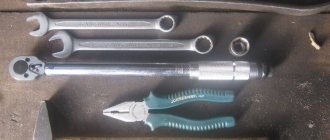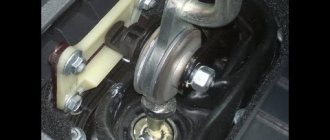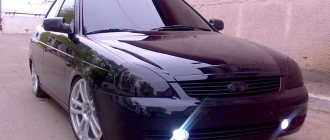10.03.2020
| (Votes: 1, Rating: 5) |
Issues discussed in the material:
- Meaning and design of the clutch
- What is a clutch pedal sensor used for?
- Clutch pedal sensor malfunctions
- How to repair and replace the clutch pedal sensor
The clutch pedal sensor is responsible for the smoothness of speed at idle and during shifts, and also affects the operation of cruise control. Malfunctions of this element will be noticeable immediately, and the driver’s task is to fix the problem in a short time.
There is nothing difficult in troubleshooting and replacing the pedal position sensor - even a novice motorist can remove and replace it by following the instructions given in the article. In addition, the number of necessary tools is small, and there is nothing specific among them. Also in the material we will tell you in more detail about the device and function of this sensor.
Clutch pedal position sensor
The clutch pedal position sensor is an ordinary limit switch with two positions - “on” and “off”.
Its normal position is open, that is, it turns on only when the clutch pedal is pressed
The following symptoms may indicate a malfunction of the clutch pedal position sensor: - car “dive” when changing gears - a sharp increase or decrease in engine speed when the clutch is disengaged
Also, if a malfunction occurs in the clutch pedal position sensor, error 0830 “Clutch pedal sensor error” is recorded in the engine controller and the “Check Engine” light in the instrument cluster turns on.
Error 0830 is recorded if the engine controller does not receive a signal from the clutch sensor: - within 2 seconds after changing gear while driving - after four gear changes at speeds above 10 km/h and engine speed above 1000 rpm The main causes of error 0830 : - malfunction of the clutch sensor itself - short circuit or open circuit - incorrect clutch pedal height Source
Source
Replacement algorithm
- It is necessary to remove the ripples from the air filter housing.
- Disconnect the terminals and other wires from the battery, remove the battery itself during repairs.
Exploded view of the engine compartment and battery.
- Unscrew the starter power supply wiring.
- From the control point it is necessary to remove the cable and wires, and also disassemble the motor protection.
Disconnect the gear shift lever.
- Clean the entire surface of the gearbox mounting to the engine and unscrew it.
We tie the box to the crossbar so that it does not fall.
- Remove the engine mount or lift it up.
- We unscrew the shafts from the gearbox using crabs.
We remove the wheel, lever and take out the transmission so that you can move the box without draining the oil.
- Move the transmission slightly away from the engine without removing the element, allowing you to begin replacing the clutch.
An engine mount is required because the mounting mounts have been removed and are shared between the engine and gearbox.
- Remove the bolts connecting the flywheel housing to the clutch disc. Press the flywheel itself with a screwdriver, while the bolts should gradually rotate in a circle.
After pulling out the box, a gap is formed that allows you to remove the clutch basket.
- Remove the disc and set it aside, even if it is in good condition. Inspect the flywheel for dents, scratches or other damage.
The clutch is old: the seals are finished and the disc is already worn with rivets.
- Install new parts or a new clutch part.
Before installing new parts, lubricate the clutch fork.
- When working with the basket, you need to “center” the disk inside. To do this, the driven element is inserted and then the pressure sheath. The spindle helps simplify the task, and when installing the elements, you need to fill the new basket, insert the centering piece into the disk and insert the flywheel.
A plastic bushing is used for alignment (some manufacturers include it in the clutch kit).
- Tighten the bolts evenly in a circle to secure the transmission to the engine.
- Connect the cable and wiring and make changes to make the entire system work properly.
Even when the first signs of a clutch malfunction appear, it is recommended to start purchasing spare parts and quickly prepare to replace the entire set.
Minor problems are always easier and cheaper to fix than major component repairs.
Symptoms of replacement
Mechanical damage can be seen only after removing the clutch from the car, but its wear can be understood by some changes that have appeared in the operation of the mechanism.
Complete replacement is recommended by the manufacturer for the following symptoms:
- Lead starts, in other words, engine power decreases.
- Slippage appears and engagement is incomplete.
- When changing gears, extraneous sounds, jolts or clicks appear.
- Sometimes the grip is lost.
- Vibrations occur when you press the clutch pedal.
When you press the clutch pedal, it falls through without effort, and with the engine running, it is impossible to engage the gear.
This is the most honest mistake. Occurs when the transmission clutch is damaged.
— the clutch cable is torn / the hydraulic drive is damaged (repaired by replacement and adjustment).
- the clutch fork was cleaned and put on the hinge (repaired by replacement or welding and adjustment).
The smell of burnt pads.
This is a very unpleasant and peculiar smell. This cannot be confused with anything.
This usually happens when starting from a stop, when trying to accelerate at high speed and when driving uphill. The reason lies in severe wear of the clutch disc. There is nothing left of its friction linings. It looks something like this:
If your car is very, very old or Chinese, the springs in the clutch basket may be worn out, but I have never seen this happen in practice.
You cannot drive for a long time with this malfunction, since slipping quickly wears out the basket and flywheel.
The only solution is to replace the clutch disc. In this case, it is advisable to replace the launch pad. Since they last about the same, they are inexpensive, and replacing them requires removing the transmission.
When driving in high gears, when you sharply press the gas pedal, the vehicle speed does not change, but the engine speed increases.
The reasons are exactly the same as in the previous case: wear of the friction linings of the driven disk.
It’s just that when driving at speed, the engine compartment and underbody are well ventilated and you can’t always smell it.
Sometimes the cause of such clutch failure is an oily clutch, but this is extremely rare.
When you press the clutch pedal, you hear a hum, noise, or grinding noise.
The reason, in most cases, lies in the wear of the thrust bearing. Depending on the design, it is modified or filled with lubricant (mainly on old machines).
You can drive for a long time with this malfunction; it is not very comfortable from an acoustics point of view. It is also important to understand that there is a possibility that the bearing will seize completely.
A guaranteed solution to the problem is to replace the thrust bearing.
A temporary solution to the problem, for example, when selling a car, is to weld the bearing in refractory grease.
It is important to understand that the work of removing and installing a gearbox is many times more expensive than replacing a release bearing.
If you hear an unpleasant “high” squeak when you press the clutch, the release bearing is completely jammed and needs to be replaced urgently; if this is not done, you will also replace the clutch basket.
If the squeaking and rattling noise is quiet, the bearing in the flywheel may have broken. But in my practice the problem arose only once. It is usually changed when the clutch basket is removed or during an engine overhaul. This is generally necessary to better preserve the gearbox input shaft bearings, its oil seal and increase the service life of the clutch disc.
Vibrations when starting off and/or when changing gears.
Vibration is usually caused by the clutch disc. Damper springs usually break or wear out:
Or the friction linings are partially destroyed:
It happens that the clutch basket itself breaks:
If your car is equipped with a dual mass flywheel, this could be a problem.
The most unlikely scenario is that the clutch release pads are installed incorrectly. The likelihood of this is extremely low, since clutch baskets with cams have not been installed on cars for 25-30 years (except UAZ).
Only removing the gearbox and disassembling the clutch will help localize the problem.
Gears are shifted with great effort, and a grinding noise is heard when shifting.
These symptoms indicate that the clutch is not disengaging completely. These clutch plates are not completely separated and the clutch plate continues to rotate.
This may be due to:
- air in the transmission hydraulic coupling (it is necessary to remove air from the system and eliminate the causes of air ingress).
- deformation or extreme wear of the clutch fork (can only be eliminated by replacement; it is useless to correct the fork).
- Incorrect clutch adjustment (adjust according to instructions).
- by melting the release pad from the plastic casing, this is especially the case for Chevrolet Niva owners. (The solution to the problem is to replace the thrust bearing).
Clutch sensor, and the secret life of kicks and failures
It’s been a while since I saw posts on forums and some strange movement around the clutch release sensor. It’s incomprehensible because no one has clear conclusions about its harms and benefits, as well as its impact on the car’s behavior, except, of course, the impact on the operation of the cruise. Therefore, I share my observation and experience on this issue. I must say, I resolved one of my main questions about the uncomfortable switching of the manual transmission from 1st to 2nd and let it go in peace, about the reasons below











